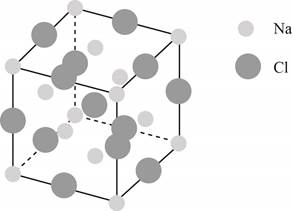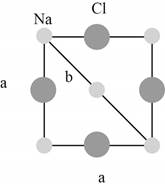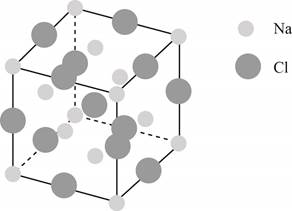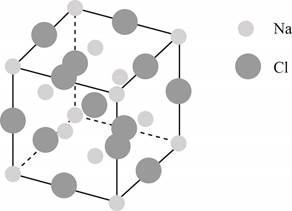
Concept explainers
(a)
Interpretation:
The closest
Concept introduction:
A unit cell of the crystal is the three-dimensional arrangement of the atoms present in the crystal. The unit cell is the smallest and simplest unit of the crystal which on repetition forms an entire crystal. Unit cell can be a cubic unit cell or hexagonal unit cell. The classification of a unit cell depends on the lattice site occupied by the atoms.
Answer to Problem 22.35E
The closest
Explanation of Solution
The structure of a face-centered cubic lattice is shown below.

Figure 1
The plane of face-centered cubic lattice that has

Figure 2
The closest
The lattice parameter
The Pythagoras theorem is shown below.
Where,
•
•
•
The hypotenuse of the triangle shown in Figure (2) is
The base and perpendicular of the triangle shown in Figure (2) are
Substitute the value of hypotenuse, base, and perpendicular in the equation (1).
Substitute the value of
Therefore, the closest
The closest
(b)
Interpretation:
The closest
Concept introduction:
A unit cell of the crystal is the three-dimensional arrangement of the atoms present in the crystal. The unit cell is the smallest and simplest unit of the crystal which on repetition forms an entire crystal. Unit cell can be a cubic unit cell or hexagonal unit cell. The classification of a unit cell depends on the lattice site occupied by the atoms.
Answer to Problem 22.35E
The closest
Explanation of Solution
The structure of a face-centered cubic lattice is shown below.

Figure 1
The plane of face-centered cubic lattice that has

Figure 3
The lattice parameter
The relation between the length of the edge of a cube
The diagonal of the triangle shown in Figure (3) is
Substitute the value of
Therefore, the closest
The closest
(c)
Interpretation:
The closest
Concept introduction:
A unit cell of the crystal is the three-dimensional arrangement of the atoms present in the crystal. The unit cell is the smallest and simplest unit of the crystal which on repetition forms an entire crystal. Unit cell can be a cubic unit cell or hexagonal unit cell. The classification of a unit cell depends on the lattice site occupied by the atoms.
Answer to Problem 22.35E
The closest
Explanation of Solution
The structure of a face-centered cubic lattice is shown below.

Figure 1
The plane of face-centered cubic lattice that has

Figure 4
The side of the trigonal plane is same as the diagonal of the of the cube.
The lattice parameter
The relation between the length of the edge of a cube
The diagonal of the triangle shown in Figure (4) is
Substitute the value of
Therefore, the closest
The closest
Want to see more full solutions like this?
Chapter 22 Solutions
Physical Chemistry
- Nanotechnology, or technology utilizing 1100 nm sized particles, has rapidly expanded in the past few decades, with potential applications ranging across far-reaching fields such as electronics, medicine, biomaterials, and consumer products, to name a few. One of the primary advantages of nanoparticles is the presence of large surface/mass ratios, resulting in enhanced surface activities compared to bulk materials. a Use the density of silver (10.49 g/cm3) to determine the number of Ag atoms in a spherical 20.-nm silver particle. b In the crystalline metallic environment, the measured radii of silver atoms has been measured to be 144 pm. Use this to calculate the atomic packing fraction of a 20.-nm silver particle. In other words, calculate the ratio of the volume taken up by Ag atoms to the volume of the entire nanoparticle. c Based on the result of part (b), silver conforms to which type of cubic crystal lattice? A simple cubic B body-centered cubic C face-centered cubic d A cubic Ag ingot having a mass of 5.0-g is processed to form a batch of 20.-nm Ag nanoparticles. Calculate the ratio of the surface area provided by the batch of nanoparticles to the surface area of the initial cube of Ag.arrow_forwardPalladium has a cubic crystal structure in which the edge of the unit cell is 389 pm long. If the density of palladium is 12.02 g/cm3, how many palladium atoms are in a unit cell? In which of the cubic unit cells does palladium crystallize?arrow_forwardIt is considered that a solid substance has an orthorhombic structure. Since the edges of the unit cell are a = 3.50Å, b = 4.0 Å, c = 5.5 Å, calculate the d and 2θ positions for the 111 plane expected in the diffraction pattern as a result of CuKα radiation (λ = 1.54 Å). b)What is the Miller index of the plane intersecting the crystal axes (2a, 1b, -3c)? please answer barrow_forward
- Express the relationship between atomic radius (r) and the edge length (a) in the bcc unit cell.arrow_forwardA solid is thought to have an orthorhombic structure. Calculate the positions D and 2θ for the plane 111 expected in the diffraction pattern as a result of CuKa radiation(λ=1.54 Å), since the edges of the unit cell are a= 3.50 Å, B=4.0 Å, C=5.5 Å.arrow_forwardThe height of a unit cell in an HCP structure was given as 5.2368Å. Determine the edge length in a unit cell.arrow_forward
 Chemistry: Principles and ReactionsChemistryISBN:9781305079373Author:William L. Masterton, Cecile N. HurleyPublisher:Cengage Learning
Chemistry: Principles and ReactionsChemistryISBN:9781305079373Author:William L. Masterton, Cecile N. HurleyPublisher:Cengage Learning Physical ChemistryChemistryISBN:9781133958437Author:Ball, David W. (david Warren), BAER, TomasPublisher:Wadsworth Cengage Learning,
Physical ChemistryChemistryISBN:9781133958437Author:Ball, David W. (david Warren), BAER, TomasPublisher:Wadsworth Cengage Learning, Chemistry: Principles and PracticeChemistryISBN:9780534420123Author:Daniel L. Reger, Scott R. Goode, David W. Ball, Edward MercerPublisher:Cengage Learning
Chemistry: Principles and PracticeChemistryISBN:9780534420123Author:Daniel L. Reger, Scott R. Goode, David W. Ball, Edward MercerPublisher:Cengage Learning Principles of Modern ChemistryChemistryISBN:9781305079113Author:David W. Oxtoby, H. Pat Gillis, Laurie J. ButlerPublisher:Cengage Learning
Principles of Modern ChemistryChemistryISBN:9781305079113Author:David W. Oxtoby, H. Pat Gillis, Laurie J. ButlerPublisher:Cengage Learning Chemistry & Chemical ReactivityChemistryISBN:9781337399074Author:John C. Kotz, Paul M. Treichel, John Townsend, David TreichelPublisher:Cengage Learning
Chemistry & Chemical ReactivityChemistryISBN:9781337399074Author:John C. Kotz, Paul M. Treichel, John Townsend, David TreichelPublisher:Cengage Learning General Chemistry - Standalone book (MindTap Cour...ChemistryISBN:9781305580343Author:Steven D. Gammon, Ebbing, Darrell Ebbing, Steven D., Darrell; Gammon, Darrell Ebbing; Steven D. Gammon, Darrell D.; Gammon, Ebbing; Steven D. Gammon; DarrellPublisher:Cengage Learning
General Chemistry - Standalone book (MindTap Cour...ChemistryISBN:9781305580343Author:Steven D. Gammon, Ebbing, Darrell Ebbing, Steven D., Darrell; Gammon, Darrell Ebbing; Steven D. Gammon, Darrell D.; Gammon, Ebbing; Steven D. Gammon; DarrellPublisher:Cengage Learning





